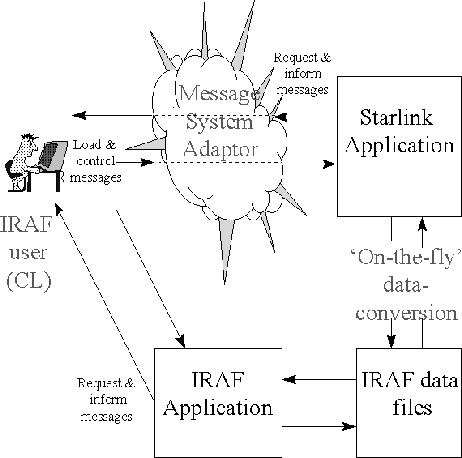 |
Next: An Infrared Camera Reduction/Analysis Package
Up: Data Analysis Applications
Previous: Data Analysis Concepts for the Next Generation Space Telescope
Table of Contents -- Index -- PS reprint -- PDF reprint
Martin J. Bly and Alan J. Chipperfield
Starlink Project1,2, Rutherford Appleton Laboratory,
Chilton, DIDCOT, Oxfordshire OX11 0QX, United Kingdom.
Email: bly@star.rl.ac.uk, ajc@star.rl.ac.uk
1Managed by the Council for the Central Laboratory of the Research Councils on behalf of the Particle Physics and Astronomy Research Council 2http://star-www.rl.ac.uk/
Modern astronomical instruments demand flexible data-analysis facilities which allow complex processing chains. Single packages, or sets of packages under one environment, may not provide all the necessary steps or may not do specific tasks as well as a package from another environment. However, the increased sophistication of software has isolated users of one package from the facilities of other packages.
Two ways to break down the barriers are:
A system has been developed to enable packages written for the Starlink Software Environment to be run from the IRAF CL so that an IRAF user can mix and match application tasks from the two environments as required to process data, all under the control of the IRAF CL.
Figure 1 shows how the components of the Starlink/IRAF inter-operability system fit together.
At the heart of the system is the Message System Adaptor (Terrett 1996). IRAF and the Starlink Software Environment have similar architectures whereby the user-interface communicates with the task by means of messages. The user-interface sends messages to control the task and the task replies with information or requests for parameters etc. The Message System Adaptor is a Tcl script which sits between the IRAF CL and the Starlink task, intercepting the messages flowing between them and converting between IRAF CLIO protocol and Starlink ADAM protocol. In this way the adaptor looks like an IRAF task to CL and like a Starlink user-interface to the Starlink task.
Starlink packages use Starlink's Extensible N-Dimensional Data Format (NDF) for data storage. The data access layer for programs is provided by the NDF subroutine library, which has the built-in ability to use externally-provided data conversion tasks to convert foreign data formats to and from the NDF format `on the fly'. This facility is used, together with tasks from Starlink's CONVERT package, to convert between NDF format and IRAF .imh or FITS format when running from IRAF. There is no need for a separate data-conversion step in the processing and the potential is there to handle many other data formats.
One pitfall with this system is that not all components of all NDFs have equivalents in the other formats, so data may be lost in the conversion process. This is particularly true of error estimate data, which are an intrinsic part of the Starlink NDF design but are absent from the other formats.
Tasks may be invoked and parameters set in the normal IRAF ways. The main differences a user will see are:
The Starlink Software Environment requires that application packages have an associated Interface File, which defines the parameters of its applications, and Package Definition Files which define the commands available and the source of help etc. Other environments, such as IRAF, require similar information presented in a different way.
So that all the files required by various environments can be generated from a single source, a generic package definition format, known as the Interface Definition Format (IFD), has been developed. The format allows environment-specific inclusion or exclusion of elements of the description, for example where an application required in one environment is not relevant in another. Tcl scripts have been written to process a package IFD file and produce the files required by the Starlink and IRAF environments. The scheme could be extended for other environments.
At present, the general purpose data reduction package FIGARO is the only Starlink package in production use under the IRAF CL. More, including the kernel applications package KAPPA and the CCD data reduction package CCDPACK, will be available soon.
The software is freely available for non-profit research use on the Starlink CD-ROM or from the Starlink Software Store at:
http://star-www.rl.ac.uk/cgi-store/storetop
Further information may be found in the Starlink documents:
This method of running packages designed for one environment from the user interface of another works well and increases the range of procedures available to users for data processing without the cost of writing new packages. Comments from users have been favourable. The system could be expanded to cover other environments, particularly where architectures and parameter systems are similar.
Tcl is a powerful tool from which to build a protocol translation system and language converters.
Following the release of the next batch of Starlink application packages for use with IRAF we intend to monitor user reaction to the products before embarking on further work in this area.
This work was done in the UK by the Starlink Project at The Central Laboratory of the Research Councils and funded by the Particle Physics and Astronomy Research Council. We are grateful for the contribution of the IRAF Programming Group at NOAO in bringing this work to fruition.
Terrett, D. L. 1996, in Astronomical Data Analysis Software and Systems V, ASP Conf. Ser., Vol. 101, eds. G. H. Jacoby and J. Barnes (San Francisco, ASP), 255
Next: An Infrared Camera Reduction/Analysis Package
Up: Data Analysis Applications
Previous: Data Analysis Concepts for the Next Generation Space Telescope
Table of Contents -- Index -- PS reprint -- PDF reprint